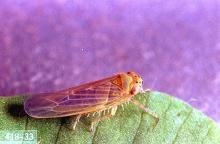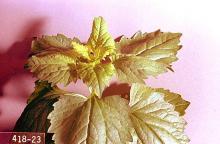Includes six-spotted leafhopper (Macrosteles fascifrons)
Pest description and crop damage The six-spotted leafhopper is also known as the aster leafhopper. It is about 0.19 inch in length, narrow, wedge-shaped, with a beak, tiny antennae, and long hind legs fringed with hairs. It is yellow or yellow-green with six black spots arranged in three rows on its head. Eggs are translucent at first but soon turn white.
Adult leafhoppers have wings. They are relatively poor fliers and tend to glide along with wind currents. Nymphs have only wing pads and cannot fly. Wingless nymphs resemble adults but are much smaller, ranging in size from 0.03 to 0.25 inch in length. They often can be distinguished by their unique sideways scuttle when disturbed. Young larvae are white but soon become yellow with brown markings.
Feeding damage causes a yellow, speckled appearance. This is usually minor. The six-spotted leafhopper is the primary vector of aster yellows phytoplasma, a serious virus-like plant disease.
Biology and life history The six-spotted leafhopper overwinters as an egg in northern locations and in the adult stage in warmer climates. It undergoes five nymphal stages before reaching adulthood. Each generation requires 27 to 34 days. There are three to four generations each year.



